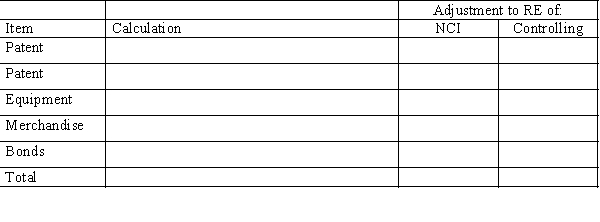Company P Industries purchased a 70% interest in Company S on January 1, 20X1, and prepared the following determination and distribution of excess schedule: 
Since the purchase, there have been the following intercompany transactions:
(1)On January 1, 20X2, Company P sold a piece of equipment with a net book value of $40,000 to Company S for $50,000. The equipment had a five-year remaining life.
(2)Each year, starting in 20X3, Company S has sold merchandise for resale to Company P at a gross profit of 20%. A summary of transactions shows the following: 
(3)On January 1, 20X5, Company P purchased Company S's 8%, $100,000 face value bonds for $98,000, which were issued at par value. The bonds have five years to maturity.
Required:
Complete the following schedule to adjust the retained earnings of the noncontrolling and controlling interest on the December 31, 20X5, worksheet for a consolidated balance sheet only. Company P uses the simple equity method to account for its investment. 
Definitions:
Direct Materials
Raw materials that are directly traceable to the manufacturing of a specific product and are an integral part of the finished product.
Actual Price
The price at which a good or service is sold in the market, as opposed to its listed or theoretical price.
Standard Costing
An accounting method that uses standard costs for cost control and financial reporting.
Variable Manufacturing Overhead
Manufacturing overhead costs that fluctuate with the level of production activity.
Q5: Partners Tuba and Drum share profits and
Q11: Per the FASB, all but the following
Q13: Property taxes are considered:<br>A)imposed tax revenues.<br>B)derived tax
Q25: Differentiate between the following monetary systems: floating
Q30: Which of the following is not true
Q37: On January 1, 20X1, Parent Company purchased
Q39: Partners A and B have a profit
Q40: Company A, an American company, owns Company
Q44: Hylie, a U.S. corporation, owns 100% of
Q61: For any given contingent liability, a company